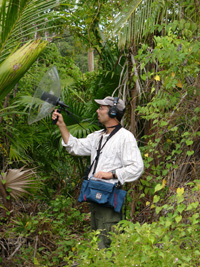
212 Schaefer Hall
240-895-2216 office
240-895-4996 fax
jjprice@smcm.edu
Education:
B.Sc.H., Queen's University, Kingston, Ontario, Canada
Ph.D., University of North Carolina, Chapel Hill, NC
Postdoctoral work, Bell Museum of Natural History, University of Minnesota, St. Paul, MN
Click here to see my C.V.
Back to SMCM Biology Homepage

Jordan Price
Evolutionary Biologist & Behavioral Ecologist ~ Professor
Joined St. Mary's College of Maryland: 2002
Courses I teach regularly at St. Mary’s include: Animal Behavior, Ecology & Evolution, Molecular Evolution, and Tropical Biology. I teach several other courses less regularly.
My primary research interests are in animal behavior and evolutionary biology. In particular, I’m interested in acoustic communication and the evolution of animal signals. Songbirds provide excellent subjects for these sorts of studies, so much of my previous research has focused on them.
My graduate research, under the direction of Haven Wiley, focused on communication and cultural transmission in the Venezuelan stripe-backed wren. This early experience gave me a keen interest in bioacoustics as well as some nasty internal parasites. Later, in my postdoctoral research with Scott Lanyon, I focused on reconstructing the evolution of complex birdsong in a group of tropical New World blackbirds called the oropendolas and caciques. This work let me pursue my interests in behavioral evolution while at the same time mastering some important new skills in molecular biology and comparative phylogenetics.
My current research combines detailed observations of animal behavior in the field with analyses in the lab to test hypotheses about the evolution of animal communication. Besides addressing interesting biological questions, this approach provides great opportunities to involve St. Mary’s students in an integrative research program that spans a range of investigative methods, from field biology to molecular techniques. Recent interests include the evolution of female bird song (described here), the evolution of echolocation in birds (described here), the evolution of sexual dichromatism (described here), and the evolution of nest architecture (described here). I like doing other sorts of field work too. I worked for several years on an NSF-funded collaboration with Kevin Omland studying vocal behavior and evolution in the New World orioles. I also teach a summer course at the University of Michigan Biological Station.
Some Recent Publications: (Click here for more Publications)
Price, J. J., K. Garcia*, and M. D. Eaton. 2024. Losses of sexual dichromatism involve rapid changes in female plumage colors to match males in New World blackbirds. Evolution 78:188-194.
Price, J. J., M.T. Willson*, and R. W. Pare*. 2023. Loss of complex female song but not duetting in the ancestors of Carolina Wrens. Ethology 129: 47-54.
Pham*, C. H., J. J. Price, J. M. Tallant, and D. N. Karowe. 2022. Climate change is predicted to reduce sympatry among North American wood-warblers. Ornithological Applications 124: 1-12.
Keenan, E. L., K.J. Odom, M. Araya-Salas, K.G. Horton, M. Strimas-Mackey, M.A. Meatte, N.I. Mann, P.J.B. Slater, J. J. Price, C. N. Templeton. 2020. Breeding season length predicts duet coordination and consistency in Neotropical wrens (Troglodytidae). Proceedings of the Royal Society B 287: 20202482.
Price, J. J.. 2019. Sex differences in song and plumage color do not evolve through sexual selection alone: new insights from recent research. Journal of Ornithology 160: 1213-1219.
Duursma, D. E., R. V. Gallagher, J. J. Price, and S. C. Griffith. 2018. Variation in avian egg shape and nest structure is explained by climatic conditions. Nature: Scientific Reports 8: 4147.
Price, J. J., and S. C. Griffith. 2017. Open cup nests evolved from roofed nests in the early passerines. Proceedings of the Royal Society B 284: 20162708.
Dority, D., J. J. Price, and S. Pruett-Jones. 2016. Yellow-bellied Sapsuckers alter sap well locations in response to experimentally induced tree damage. Wilson Journal of Ornithology 128: 619-623.
Sturge, R. J., K. E. Omland, J. J. Price, and B. Lohr. 2016. Divergence in calls but not songs in the Orchard Oriole complex: Icterus spurius and I. fuertesi. Journal of Avian Biology 47: 109-120.
Price, J. J. 2015. Rethinking our assumptions about the evolution of bird song and other sexually dimorphic signals. Frontiers in Ecology and Evolution 3: 40. doi: 10.3389/fevo.2015.00040
Odom, K. J., K.E. Omland, and J. J. Price. 2015. Differentiating the evolution of female song and male-female duets in the New World blackbirds: can tropical natural history traits explain duets? Evolution 69: 839-847.
Price, J. J., and M. D. Eaton. 2014. Reconstructing the evolution of sexual dichromatism: current color diversity does not reflect past rates of male and female change. Evolution 68: 2026-2037.
Price, J. J., and C. L. Crawford. 2013. Use and characteristics of two singing modes in Pine Warblers. Wilson Journal of Ornithology 125: 552-561.
Johnson, A. E., J. J. Price and S. Pruett-Jones. 2013. Different modes of evolution in males and females generate dichromatism in fairy-wrens (Maluridae). Ecology and Evolution 3: 3030-3046.
Greig, E. I., J. J. Price and S. Pruett-Jones. 2013. Song evolution in Maluridae: both natural and sexual selection influence acoustic structure. Emu 113: 270-281.